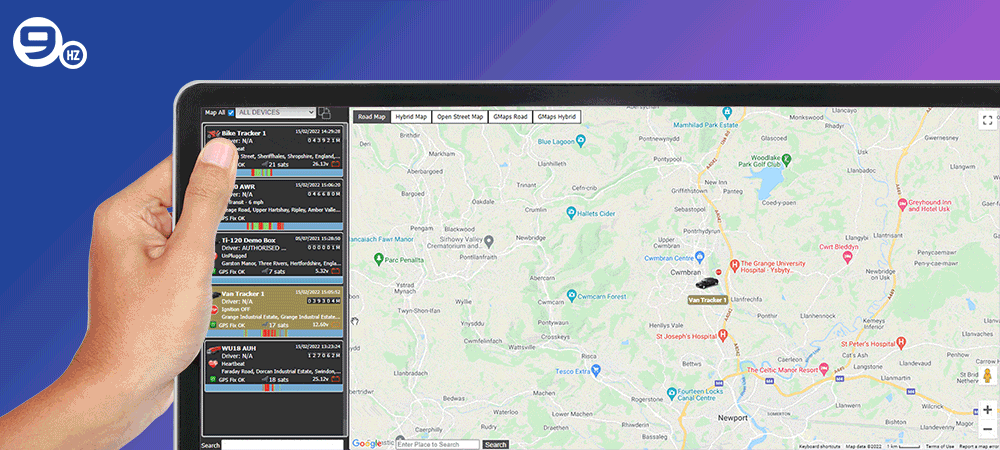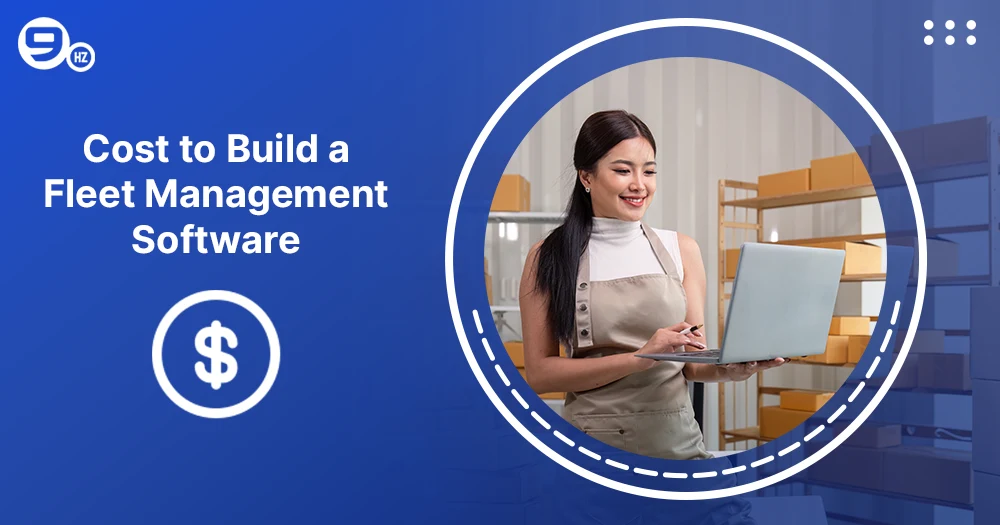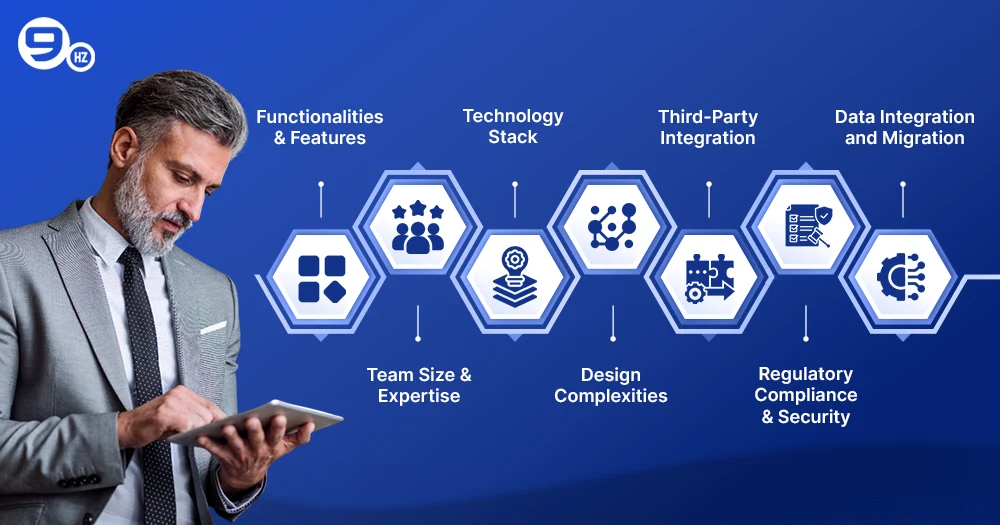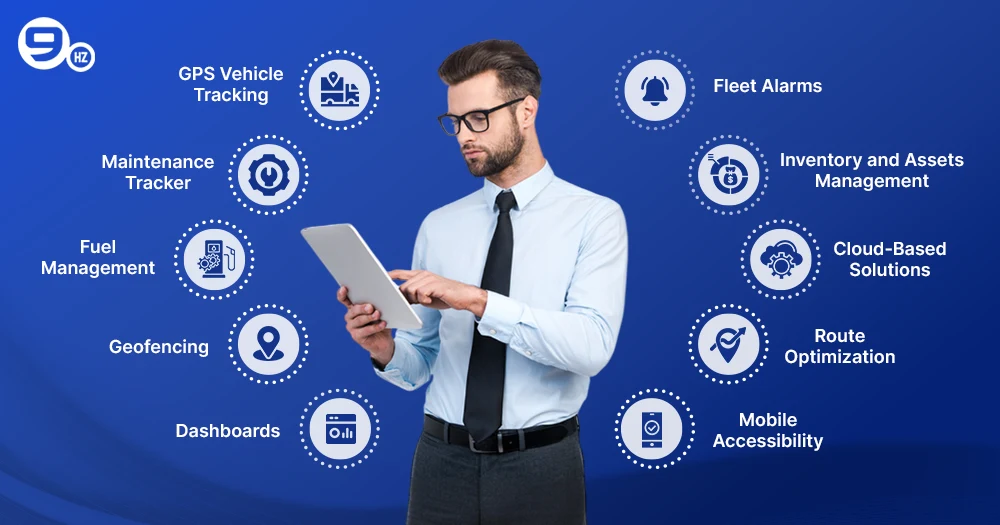As global businesses are expanding with international territories and sea trade routes, the demand for fleet management software scales up to track commercial vehicle activities. Businesses are constantly aiming to scale their operation and reduce costs with this dynamic software. It can majorly target market segments for cloud-based solutions through deployment to scale its flexibility, scalability, and cost-effectiveness. Some of the key adopters of fleet tracking software are delivery services, transportation and logistics, and field service companies.
Based on research done by Fortune Business Insights, the market size of software for fleet management is set to show a high growth trajectory with a CAGR of 19.8% and to increase from $27.55 billion in 2024 to $116.56 billion by 2032. In coming years, the market is expected to increase with EV adoption, mobility-as-a-service use, and rising investment in vehicle fleets.
Overall, the cost to build fleet management software will be around $10,000-$20,000 for the basic version, while for more advanced software where there will be features liek, it can range between $20,000 – $2,00,000 depending on the development platform, features, technologies, and UI/UX design.
If you’re considering Fleet Management Software Development Services, understanding the cost breakdown is crucial. Let’s explore the development costs and the key factors influencing them in this comprehensive guide.
What is Fleet Management Software?
Fleet vehicle monitoring system is a single digital platform designed to help businesses optimize fleet operations and reduce costs. It has key features such as real-time GPS tracking, maintenance and tracking, fuel management, reporting, and analysis. Due to its advanced mechanism, it can locate any specific vehicle with details, monitor driver behavior, manage fuel costs, schedule vehicle maintenance, and simplify compliance.
The technology used to develop fleet management software is powered by telematics devices that create functionality to capture real-time tracking of vehicle movements. It supports transmitting data from the vehicle to the cloud storage using cellular or satellite communication networks. The systems interpret and visualize the data.
Core Benefits of Using Fleet Tracking System:
- With the use of GPS technology, fleet monitoring software provides the details of real-time updates and vehicle locations.
- It tracks time, and in-built integration can help schedule maintenance and improve engine health.
- Fleet software also supports automated trip routing.
- It consistently helps in monitoring driver behaviors to send alerts and ensure safety.
- This system helps track operational costs and control the budget.
- Additionally, it manages contracts by updating leases and other deals to send warning mail.
Simplify Fleet Management Today!
Build a Custom Software Solution for Your Fleet
Cost to Develop Fleet Management Software
Fleet Management software cost depends on multiple factors, such as building an MVP, coding hours, UI/UX design, and backend server hours. Depending on complexities like the feature of real-time reports, vehicle management and maintenance, compliance management, and app size there will be variations in development costs.
Let’s understand in-depth the cost distribution of fleet management solutions by explaining each feature:
| Pricing Model | Price Range | Features |
|---|---|---|
| Basic | $30,000–$50,000 |
|
| Moderate | $50,000–$150,000 |
|
| Complex | $150,000+ |
|
How is AI used in Fleet Management?
Artificial intelligence in fleet monitoring has been a core technological pivot that helps integrate new automation and drives advancement for better efficiencies and safety. By predicting fuel consumption, analyzing traffic patterns, and identifying cost-saving opportunities, AI is transforming how fleet managers operate, leading to reduced fuel costs and better overall fleet management.
- AI can analyze data from vehicle sensors to predict maintenance needs and reduce downtime. When combined with vendor management software development, fleet operators can automate vendor coordination for timely maintenance and repairs, ensuring minimal disruptions.
- It identifies risky behaviors with telematics data of braking and acceleration patterns to improve safety and better driving practices.
- Self-driving mechanisms and drones can provide more assurance of safety guidelines.
- It optimizes for route optimization using KPIs to improve vehicle utilization and deliveries.
- A system backed with AI helps detect unusual engine vibrations, send alerts scheduled for maintenance checks, and fix issues of potential breakdown.
Factors Affecting the Cost of Building Fleet Tracking Software
Developing standard software for fleet management comes with many complexities, and it takes time and effort to understand each feature. Therefore, businesses should choose the right software development company to ensure that all factors are carefully considered, ultimately delivering the best user experience.
1. Functionalities & Features
One of the foremost factors in deciding on the cost of developing a fleet tracking system is its features and functionality. Basic software requires less investment, but integrating advanced features like AI, analytics, and IoT integration can directly increase costs. As the number of features increases, it will ultimately scale overall cost.
2. Team Size & Expertise
The decision of team size and their expertise level can influence the decision of fleet management system development cost. So, if you invest in in-house teams, it will have high fixed costs to hire the best talent and set up resources and infrastructure for their execution, while outsourcing software to a software development company with senior developers or UI/UX designers can reduce costs for the location.
3. Technology Stack
Choosing the right technology, such as AI-driven GPS trackers, sensors, forecasting tools, and business intelligence systems, along with managing SQL or NoSQL databases, cloud-based hosting, and programming languages like JavaScript, Java, or Python, can impact development costs. If API integrations and third-party services are more complex, the costs will increase further due to subscription models and usage-based pricing.
4. Design Complexities
UI/UX design for fleet management software can fluctuate the overall cost estimation. So, if you prefer a simple design with minimal graphics, there will be less cost involved. On the other hand, advanced or highly interactive design with data visualization, complex dashboards, and custom reports can further increase the cost of developing and hiring experts.
5. Third-Party Integration
Fleet monitoring systems can easily integrate with other systems, including CRM, ERP, payment gateways, and other hardware. This integration enhances functionality and improves results for complex tasks, but it also adds additional costs related to custom design and development. Some of these costs include usage fees, subscription fees, and data charges.
6. Regulatory Compliance & Security
Due to the rising threat of data security and compliance structure of the software industry, multiple factors can add to fleet management software development costs. It includes implementing security standards, encryptions, access controls, and secure authentication. Strict compliance like GDPR, CCPA, and other robust data security can add to development costs.
Data Integration and Migration
Another crucial factor that affects the development cost, is integration, and migrating crucial data can be a time-consuming and complex task. It can widely depend on the complexities related to integration, like data incompatibility and format issues, technical expertise, data security, and resource constraints. Although, it is a viable investment to ensure the confidentiality of sensitive data.
Take Control of Your Fleet with Tailored Software
Enhance Efficiency and Save Costs Today!
Top 5 Companies Using Fleet Management System
Every industry requires streamlined logistics solutions to deliver products on time and with no damage to vehicles, ensuring driver safety; companies are investing in fleet management solutions to overcome these challenges. These versatile tools serve multiple applications of reducing costs, enhancing safety, improving capabilities, and regulatory compliance. Following this, fleet managers can operate smoothly without the risk of vehicle breakdown and downtime.
Here is a comparison table to represent the top 5 brands that are using fleet management software with its features and applications:
| Industry | Company | Key Areas of Fleet Tracking Software Usage | Benefits |
|---|---|---|---|
| Courier & Logistics | FedEx | Fleet tracking, Compliance Management, Driver behavior monitoring, Maintenance scheduling | Enhanced fleet safety by 2x, better route planning, cost savings |
| Retail & Supply Chain | Walmart | Route planning, Real-time Vehicle tracking, Driver safety, Fuel management | Reduced fuel expenses, improved delivery efficiency |
| Food & Beverage | PepsiCo | Fleet management for distribution, Driver performance, Route optimization, Vehicle maintenance | Increased fleet reliability, lower maintenance costs |
| E-commerce & Logistics | Amazon | Vehicle tracking, Route optimization, Driver safety, Real-time inventory management | Improved delivery times, cost reduction, enhanced safety |
| Courier & Logistics | UPS | Predictive maintenance, Route optimization, Fuel consumption monitoring, Driver behavior analysis | Increased operational efficiency, reduced fuel costs |
10 Must-Have Features to Build Fleet Management Solution
The selection of features for developing fleet tracking software depends on software size and functionalities requirements for business. Each feature has a specific purpose to deliver a few sets for operation while others handle upgradation and ensure the effectiveness and efficiency of fleet operations.
GPS Vehicle Tracking
It is an essential feature to constantly monitor fleet movements that helps to ensure driver’s safety. With the help of this system, it gets easier to analyze routes, reduce unauthorized use of vehicles, and enhance security. Also, the quality of risk reduction makes it a valuable investment to avoid speeding, harsh braking, and rapid accelerations.
Maintenance Tracker
Using a maintenance tracker can help a business to keep their vehicles in optimal condition and schedule repair histories. It supports the risk of breakdowns and helps in extending vehicle lifespans. Following the potential implementation of the tracker can significantly improve repairs and vehicle reliability. With focused results, real-time data and insights can help with data-driven decision-making.
Fuel Management
One of the key features is that it helps to track down fuel consumption and track for any inefficiencies. Businesses can implement strategies for reducing cost, and resource wastage and optimize fueling practices. Integrating this system generates data for tracking fuel usage and identifying potential discrepancies. It can upgrade overall fuel efficiency but outweighs initial investment.
Geofencing
Using the feature of geofencing can allow fleet managers to set virtual boundaries for vehicles. When a vehicle enters or exits from predefined zones, it will trigger the alerts. It can enhance security, help in tracking unauthorized usage, and improve operational efficiencies.
Dashboards
This can provide a broad overview of fleet performance metrics that enable quick decision-making. Additionally, it has the customizable feature of displaying relevant data, such as maintenance schedules, driver behavior, and fuel consumption. This can work to enhance visibility and data-driven insights. Apart from the results, it identifies key areas to improve fuel consumption, maintenance, and driver behavior.
Fleet Alarms
These are designed to alert fleet managers to handle maintenance issues and locate unusual activity. It can provide proactive notifications to address potential problems and escalate to ensure the vehicle’s optimal condition. Fleet alarms can work for preventative benefits and potential savings to avoid repairs. This detects harsh braking, fatigue detection, overspeeding, and accident detection.
Inventory and Assets Management
Using asset control features helps fleet operators constantly monitor vehicle inventory, spare parts, and other assets. It ensures that vehicle resources and equipment are efficiently managed and available whenever required. Additionally, it supports tracking stock levels and delivery status to reduce errors and improve operational efficiency.
Cloud-Based Solutions
It delivers flexible services for cloud-based SaaS and on-premise solutions to customize for business requirements. Using the cloud option allows for remote access and easy updates with more control over data. On-premise provides full control for data and system infrastructure, reducing dependence on external networks. This helps to add the advantage of accessibility, scalability, automated updates, and integration capabilities.
Route Optimization
Adopting the features of route optimization and planning can help save more time, money, and fuel. Integrating AI into the system supports analyzing real-time weather and traffic conditions, dynamic routing, and predictive analytics to pick the most efficient routes. It also reduces delivery times and fuel consumption with dynamic routing, multi-stop routing, predictive analysis, or cost-efficiency metrics.
Mobile Accessibility
Fleet tracking software should not be limited to just your desk; it requires mobile-friendly app optimization for better access. This helps you easily convert data and reports to send quick and fast updates from your phone. Also, it updates the notification alerts in a timely manner and makes it easy to check in updates from anywhere, making drivers self-sufficient and independent.
How can The NineHertz help you in Fleet Management Software Development?
If you are searching for the best fleet management software development services with maximizing profit, The NineHertz is here to streamline your Mobility Operations. We offer versatile services such as dispatch management systems, vehicle management software, fleet tracking tools, accident detection, analytics & reporting , fleet management application consulting services, and app development.
The NineHertz is one of the software development companies offering AI-integrated features to elevate operational efficiencies. It has already completed the milestone of launching over 800+ projects with a 92% client retention rate. More than 500+ experts are here to deliver the best capabilities for industry 4.0 technologies. Technical experts are scaling the game by integrating big data, AI, machine learning, blockchain, IoT, Robotic process automation, and Metaverse. Get your fleet management software ready with the fixed-price model, hourly basis, and hybrid model.
Conclusion
Fleet management software is widely used across industries, such as logistics and transportation, construction, food & beverage delivery, retail and e-commerce, or manufacturing. Developers can modify features based on unique demands and backed by deep research and integrated functionalities. Determining the fleet management software development cost comes with a multifaceted process of considering multiple factors. Ultimately, the software development process can result in setting up a balance between usability, long-term scalability, and functionality.
So, as data-driven decision-making thrives across multiple industries, fleet monitoring software will be demanded. Developers will take time and resources to analyze fleet management system development costs to comprehend its suitability and create standard software.
Frequently Asked Questions (FAQs)
How Does Fleet Tracking Software Work?
Fleet management software works in a streamlined process of collecting data, processing it, and then adding key functionalities to ensure real-time decision-making. It provides insights into vehicle location, maintenance schedules, and fuel usage.
How to Create a Fleet Monitoring System?
For creating fleet software, the first step is to define your target audience and features. Afterward, select the right tech stack either on the cloud or on-premise, develop modules, and integrate API for mapping. Lastly, deployment will be done with testing for support and updates.
How Much Does an AI-Powered Fleet Management Software Cost?
The cost of an AI-powered fleet monitoring system varies and depends on its features and complexities. It can typically range between $50,000 to $2,00,000 for developing basic to advanced featured software like artificial intelligence and IoT features.
How to Reduce the Cost of Building a Fleet Management System?
To reduce the development cost, developers can use open-source tools and pre-built modules. So, opting out of cloud-based deployment helps in avoiding infrastructural expenses. You can even outsource to experienced developers to minimize the cost of building fleet management software.














